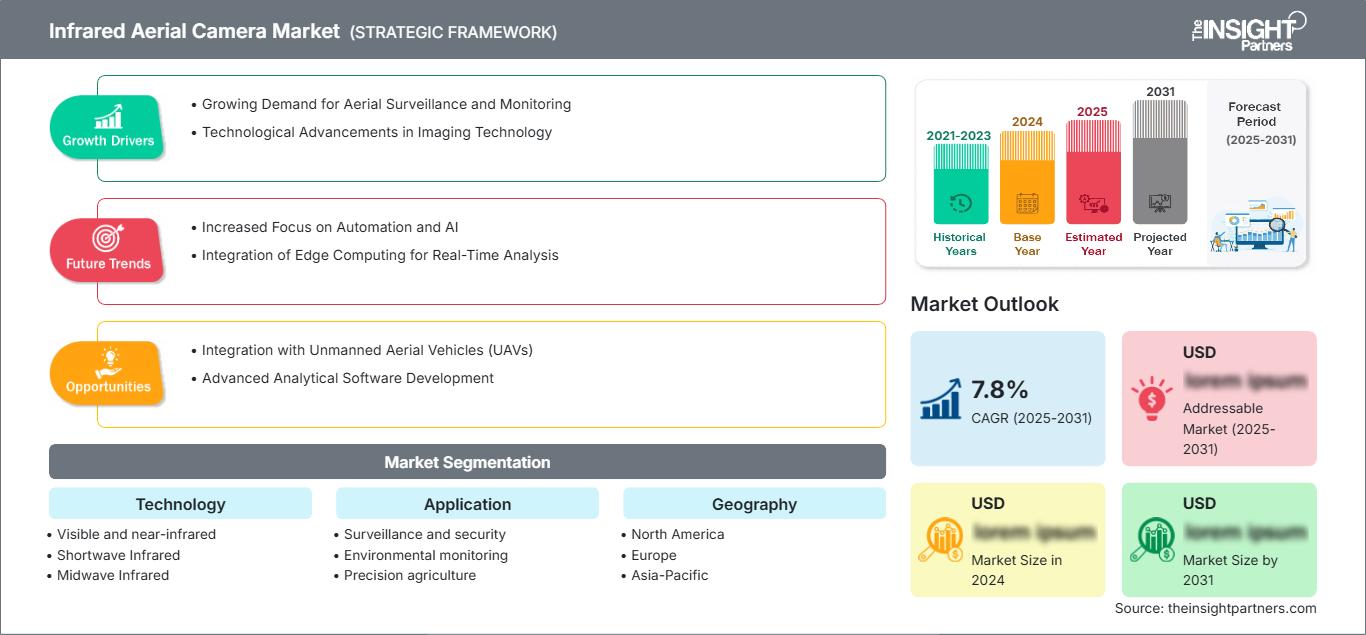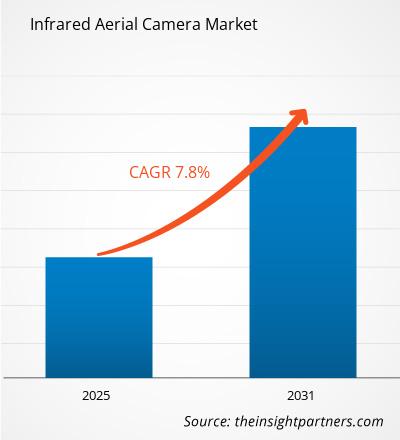Si prevede che il mercato delle telecamere aeree a infrarossi registrerà un CAGR del 7,8% dal 2025 al 2031, con una dimensione del mercato in espansione da XX milioni di dollari nel 2024 a XX milioni di dollari entro il 2031.
Il rapporto è segmentato per tecnologia (visibile e vicino infrarosso (VNIR), infrarosso a onde corte (SWIR), infrarosso a onde medie (MWIR), infrarosso a onde lunghe (LWIR)); applicazione (sorveglianza e sicurezza, monitoraggio ambientale, agricoltura di precisione, ispezione delle infrastrutture); area geografica (Nord America, Europa, Asia-Pacifico, Medio Oriente e Africa, Sud e Centro America). L'analisi globale è ulteriormente suddivisa a livello regionale e per i principali paesi. Il rapporto offre il valore in USD per l'analisi e i segmenti sopra indicati.
Scopo del rapporto
Il rapporto "Infrared Aerial Camera Market" di The Insight Partners mira a descrivere il panorama attuale e la crescita futura, i principali fattori trainanti, le sfide e le opportunità. Ciò fornirà spunti a vari stakeholder aziendali, come:
- Fornitori/Produttori di tecnologia: per comprendere le dinamiche di mercato in evoluzione e conoscere le potenziali opportunità di crescita, consentendo loro di prendere decisioni strategiche informate.
- Investitori: per condurre un'analisi completa delle tendenze in merito al tasso di crescita del mercato, alle proiezioni finanziarie di mercato e alle opportunità esistenti lungo la catena del valore.
- Enti di regolamentazione: per regolamentare le politiche e le attività di controllo sul mercato con l'obiettivo di ridurre al minimo gli abusi, preservare la fiducia degli investitori e sostenere l'integrità e la stabilità del mercato.
Tecnologia di segmentazione del mercato delle telecamere aeree a infrarossi
- Visibile e vicino infrarosso
- Infrarosso a onde corte
- Infrarosso a onde medie
- Infrarosso a onde lunghe
Applicazione
- Sorveglianza e sicurezza
- Monitoraggio ambientale
- Agricoltura di precisione
- Ispezione delle infrastrutture
Potrai personalizzare gratuitamente qualsiasi rapporto, comprese parti di questo rapporto, o analisi a livello di paese, pacchetto dati Excel, oltre a usufruire di grandi offerte e sconti per start-up e università
Mercato delle telecamere aeree a infrarossi: Approfondimenti strategici

-
Ottieni le principali tendenze chiave del mercato di questo rapporto.Questo campione GRATUITO includerà l'analisi dei dati, che vanno dalle tendenze di mercato alle stime e alle previsioni.
Fattori di crescita del mercato delle telecamere aeree a infrarossi
- Crescente domanda di sorveglianza e monitoraggio aerei: a causa della crescente necessità di sorveglianza aerea in agricoltura, monitoraggio ambientale e messa in sicurezza degli spazi urbani e rurali, il mercato delle telecamere aeree a infrarossi è fortemente motivato. Le telecamere si dimostrano cruciali nel fornire informazioni preziose sulla salute delle colture, nel rilevare incendi boschivi e nel rafforzare la sicurezza nelle città. Grazie alle immagini termiche, le installazioni di telecamere a infrarossi possono monitorare efficacemente lo spazio in un ambiente con visibilità limitata, il che le rende essenziali in molteplici applicazioni.
- Progressi tecnologici nella tecnologia di imaging: il mercato delle telecamere aeree a infrarossi è destinato a espandersi grazie al continuo sviluppo dei fattori tecnologici legati alla tecnologia di imaging a infrarossi. Il miglioramento della sensibilità dei sensori, la migliore risoluzione delle immagini e i risultati nell'elaborazione dei dati sono tutti fattori che rendono le telecamere a infrarossi più efficienti e versatili. Pertanto, con l'espansione della tecnologia, i costi delle termocamere continuano a diminuire, soddisfacendo sia le esigenze delle grandi aziende che dei piccoli agricoltori.
Tendenze future del mercato delle termocamere a infrarossi
- Maggiore attenzione all'automazione e all'intelligenza artificiale: l'attenzione all'automazione e all'intelligenza artificiale è in aumento in termini di trend nell'analisi dei dati delle termocamere a infrarossi. I sistemi automatizzati elaborano rapidamente enormi volumi di dati termografici, rendendo invisibili all'occhio umano elementi visibili: modelli e anomalie. Questa tendenza in via di sviluppo è particolarmente rilevante per il settore agricolo, dove l'intelligenza artificiale contribuisce a ottimizzare le pratiche di gestione sulla base di informazioni provenienti dai dati termici.
- Integrazione dell'edge computing per l'analisi in tempo reale: il futuro delle termocamere a infrarossi vedrà una maggiore integrazione dell'edge computing, consentendo l'elaborazione dei dati in tempo reale direttamente sul dispositivo. Ciò migliorerà la velocità e l'efficienza dell'analisi delle termocamere, fornendo informazioni immediate per settori come l'agricoltura, l'energia e le infrastrutture. Con algoritmi basati sull'intelligenza artificiale all'avanguardia, il processo decisionale sarà più rapido e preciso, migliorando l'efficienza operativa e la reattività.
Opportunità di mercato per le telecamere aeree a infrarossi
- Integrazione con veicoli aerei senza pilota (UAV): l'integrazione di telecamere aeree a infrarossi con UAV, o droni, rappresenta una nuova grande opportunità da sfruttare. I droni con termografia consentono la scansione rapida ed efficiente di ampie aree, rendendoli particolarmente utili per applicazioni come la ricerca e il soccorso, il monitoraggio della fauna selvatica e l'ispezione delle infrastrutture. Con la continua espansione del mercato dei droni, potrebbe aumentare anche la necessità di telecamere a infrarossi compatibili, aprendo nuove strade all'innovazione e alla collaborazione.
- Sviluppo di software analitico avanzato: le aziende hanno la possibilità di sviluppare software avanzato per integrare le telecamere aeree a infrarossi. I produttori possono offrire strumenti per l'analisi e la visualizzazione dei dati per aumentare il valore dei loro prodotti di imaging. Il software può facilitare una migliore interpretazione dei dati termici per migliorare la qualità del processo decisionale e dei risultati in applicazioni quali l'agricoltura e il monitoraggio ambientale.
Mercato delle telecamere aeree a infrarossi
Le tendenze regionali e i fattori che influenzano il mercato delle telecamere aeree a infrarossi durante il periodo di previsione sono stati ampiamente spiegati dagli analisti di The Insight Partners. Questa sezione illustra anche i segmenti e la geografia del mercato delle telecamere aeree a infrarossi in Nord America, Europa, Asia-Pacifico, Medio Oriente e Africa, America meridionale e centrale.
Ambito del rapporto di mercato delle telecamere aeree a infrarossi
| Attributo del rapporto | Dettagli |
|---|---|
| Dimensioni del mercato in 2024 | US$ XX million |
| Dimensioni del mercato per 2031 | US$ XX Million |
| CAGR globale (2025 - 2031) | 7.8% |
| Dati storici | 2021-2023 |
| Periodo di previsione | 2025-2031 |
| Segmenti coperti |
By Tecnologia
|
| Regioni e paesi coperti |
Nord America
|
| Leader di mercato e profili aziendali chiave |
|
Densità degli operatori del mercato delle telecamere aeree a infrarossi: comprendere il suo impatto sulle dinamiche aziendali
Il mercato delle telecamere aeree a infrarossi è in rapida crescita, trainato dalla crescente domanda degli utenti finali, dovuta a fattori quali l'evoluzione delle preferenze dei consumatori, i progressi tecnologici e una maggiore consapevolezza dei vantaggi del prodotto. Con l'aumento della domanda, le aziende stanno ampliando la propria offerta, innovando per soddisfare le esigenze dei consumatori e sfruttando le tendenze emergenti, alimentando ulteriormente la crescita del mercato.

- Ottieni il Mercato delle telecamere aeree a infrarossi Panoramica dei principali attori chiave
Punti di forza
- Copertura completa: il rapporto analizza in modo esaustivo prodotti, servizi, tipologie e utenti finali del mercato delle telecamere aeree a infrarossi, offrendo una panoramica olistica.
- Analisi degli esperti: il rapporto è redatto sulla base della conoscenza approfondita di esperti e analisti del settore.
- Informazioni aggiornate: il rapporto garantisce la pertinenza aziendale grazie alla copertura di informazioni e tendenze dei dati recenti.
- Opzioni di personalizzazione: questo rapporto può essere personalizzato per soddisfare le esigenze specifiche del cliente e adattarsi in modo appropriato alle strategie aziendali.
Il rapporto di ricerca sul mercato delle telecamere aeree a infrarossi può quindi contribuire a guidare il percorso di decodificazione e comprensione dello scenario del settore e delle prospettive di crescita. Sebbene possano esserci alcune preoccupazioni valide, i vantaggi complessivi di questo rapporto tendono a superare gli svantaggi.
- Analisi storica (2 anni), anno base, previsione (7 anni) con CAGR
- Analisi PEST e SWOT
- Valore/volume delle dimensioni del mercato - Globale, Regionale, Nazionale
- Industria e panorama competitivo
- Set di dati Excel
Report recenti
Rapporti correlati
Testimonianze
Motivo dell'acquisto
- Processo decisionale informato
- Comprensione delle dinamiche di mercato
- Analisi competitiva
- Analisi dei clienti
- Previsioni di mercato
- Mitigazione del rischio
- Pianificazione strategica
- Giustificazione degli investimenti
- Identificazione dei mercati emergenti
- Miglioramento delle strategie di marketing
- Aumento dell'efficienza operativa
- Allineamento alle tendenze normative






















 Ottieni un campione gratuito per - Mercato delle telecamere aeree a infrarossi
Ottieni un campione gratuito per - Mercato delle telecamere aeree a infrarossi